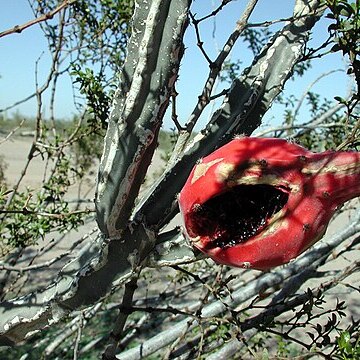Shrubs, erect to sprawling, usually inconspicuous. Roots turnip-shaped, usually 15-30 × 5-12 cm (much larger ones known). Stems gray-green to gray, simple or with 2-5 branches, 40-120(-300) cm, distally 8-20 mm diam., at midlength ca. 10 mm diam., often narrowed toward base; wood hollow, solid-surfaced cylinders, 4-7 mm diam.; ribs 4-6, prominent; areoles (3.5-)12(-15) mm apart along ribs, circular to elliptic, 2-5 × 2 mm. Spines (9-)11-15(-17) per areole, usually in 3 vertical rows; abaxial 3-5 spines appressed, yellowish white throughout or only at tips, to 3 mm, puberulent when young; adaxial spines black, subulate, to 1 mm. Flowers: nocturnal (remaining open next day), 15-25 cm; scales of flower tubes green, tipped red or brown; outer tepals greenish white with brown to reddish midstripes; inner tepals white or lightly tinged cream or pink (or rarely all rose-pink), lanceolate-attenuate, apiculate, 4-7 cm, attenuate to mucronate; stamens 2.5 cm; anthers cream-yellow, 2 mm; style white, 10-14 cm; stigma lobes 9-11, white. Fruits bright red, darkening in age, ellipsoid, 60-90 × 40-50 mm. Seeds 3-4 × 2-2.5 mm. 2n = 22.
More
A cactus. It has slender shoots up to 3 m long. It spreads 50 cm wide. The shoots tend to become woody. They have large turnip like roots. These can be 60 cm across and weigh 60 kg. Flowers open at night. They are white. They are 15-20 cm across. The fruit are red oval seed pods. They are edible.
Xerophyllous scrub, often under creosote bushes in desert flats and washes, which further reduces visibility, it also grows on rocky mountain slopes.
More
It is a warm temperate to subtropical plant. It suits hardiness zones 8-11.
The root or tuber is baked, peeled and eaten. They are dipped in batter and made into fritters. The tubers can be cut into small strips, soaked in cold water for 30 minutes then drained and dried and deep fried. The fruit are eaten raw, cooked or made into jam. The stalks are eaten as greens.


